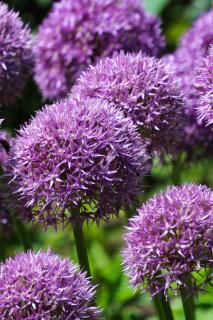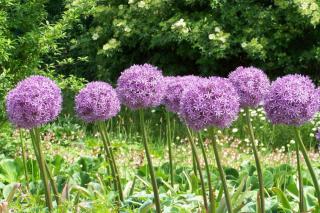

Allium is a superb flower, famous for its surprising ornamental floral scapes.
Name – Allium giganteum
Family – Liliaceae (lily family)
Type – perennial
Height – 8 to 40 inches (20 to 100 cm)
Exposure – full sun
Soil – ordinary, better if acidic
Flowering – May to July
Easy to grow, it is perfect in flower beds or in pots and garden boxes to decorate your terrace or balcony.
Allium giganteum is planted in fall more or less 4 to 5 inches (10 to 12 cm) deep in light soil.
A good tip to know how deep to plant it is to multiply the height of the bulb by 3. If it is 2 inches (5 cm) tall, plant 6 inches (15 cm) deep.
Caring for allium is extremely easy, since the needs of this perennial bulb plant are not difficult to meet.
In both pots and in the ground, they will bear nice flowers without asking you to care for them.
 Cut wilted flower scapes as they die off, cutting the stem off as short as you can.
Cut wilted flower scapes as they die off, cutting the stem off as short as you can.Note that allium leaves tend to turn yellow before or after the blooming of the large umbels, and so it helps to plant ground-covering perennials around the giant onion plants, to cover the wilted leaves and only let the flower stem stick out.
As for pot-growing allium, remember to water regularly because water needs are higher due to the fact that potted plants tend to dry off faster.

Native to Europe and Asia, this ornamental onion belongs to the same genus as the following species: edible garlic, onion, shallot, chives and belongs to the same family as leek.
The different Allium varieties all boast superb flowers bunched up in balls and the size and color of this ball depends on the variety.
In flower beds or along edges, and also along a wall or simply plunked in the middle of the yard, the ornamental impact of this plant is guaranteed!
It is also used in flower bouquets, because the foliage and the flowers both can be used to make appealing bouquets.
For the taller species you can stake the stem to keep it from folding under the wind. Nice for this is to use bamboo, it is perfectly suited and actually enhances the visual impact of the plant.